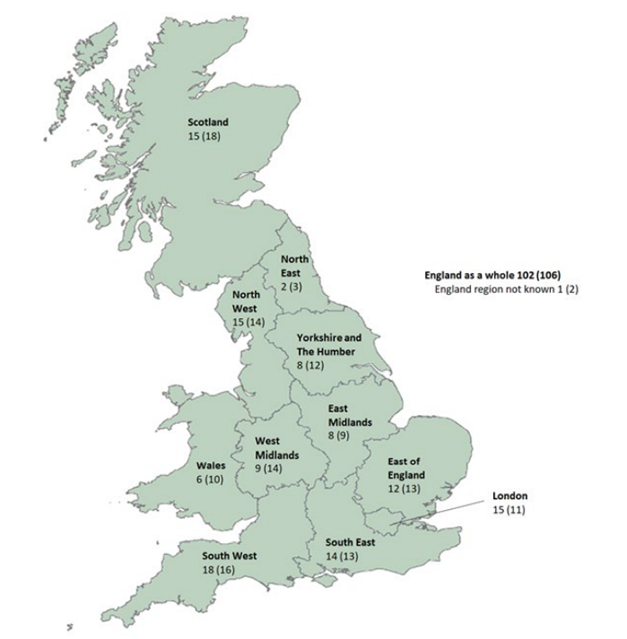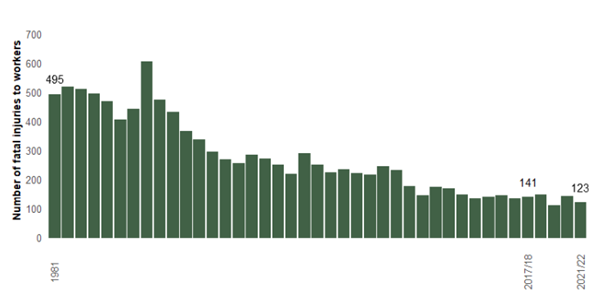A recent publication from the Health and Safety Executive provides an insightful and comprehensive analysis of fatal injuries in the workplace in Great Britain in 2022.
The report provides headline numbers on deaths resulting from a work-related accident in 2021/22 that were reportable under the Reporting of Injuries, Diseases and Dangerous Occurrences Regulations (RIDDOR) to any of the main enforcing authorities for health and safety at work.
Fatal injuries in the United Kingdom still present a real threat to businesses, their staff, and the public. Many businesses fall short in ensuring they are compliant with health and safety legislation, and by doing so put the safety of their employees at risk. A business should ensure that they are constantly doing everything in their power to ensure their employees are safe and confident going into their place of work.
In this blog, we will break down the main findings of the report on workplace fatal injuries in Great Britain 2022 and outline what your business can be doing to ensure it is keeping its employees safe within the workplace.
Main findings

(Workplace fatal injuries in Great Britain, 2022)
Out of the 123 deaths in the workplace, around a quarter of deaths (30) were in the Construction sector. This was followed by Agriculture, Forestry and Fishing (22) and Manufacturing (22).
The sector/industry to have the lowest count of fatal injuries is Waste and Recycling with 1 death followed by unspecified industries with 9 deaths, then wholesale retail, motor repair, accommodation, and food, all with 11 deaths.

(Workplace fatal injuries in Great Britain, 2022)
Out of 123 deaths in 2021/22 happening in the workplace, 93 of those were aged 16-59. 29 were aged 60 or over. However, those in the age bracket 60+ only make up 11% of the workplace.
The graph above illustrates that the risk of fatal injury increases with age as workers within the 60+ age bracket have twice the average rate across all age groups. Those 65+ have a rate of four times as high as the average rate across all age groups. Thus, the chance of fatal injury increases with age.
This can be seen easily through the bar chart below that shows the rate of fatal injuries by age group (per 100,000 workers), the annual average for 2017/18 – 2021/22p)

(Fatal Injuries by age group 2017/18-2021/22).

(Cause of death – Main kinds of fatal accidents for workers 2021/22, Workplace fatal injuries in Great Britain, 2022)
Note: Chart above shows all accidents kinds accounting for 10 or more deaths in 2021/22
As can be seen in the above graphic, falling from a height has continued to be the largest cause of death in the workplace. This is followed by being struck by a moving vehicle and struck by moving including flying/falling objects.
Rate of injury is shown per 100,000 workers

(Workplace fatal injuries in Great Britain, 2022)
The line graph above shows a steady decrease in the rate of fatal injuries to workers in Great Britain. However, in recent years prior to the pandemic, the downward trend plateaued.
Furthermore, 80 members of the public were killed in 2021/22 due to work-related accidents, indicating that workplace safety is not just vital for the protection of staff, but also for the general public.
Injuries by country within GB

The above figure shows the number of fatal injuries by country and region within Great Brittain in 2021/22. The number of fatalities in some regions is relatively small, hence susceptible to considerable variation.
Accidents involving multiple fatalities can also affect annual totals. Therefore, the figure also shows the annual average number of deaths for the five years 2017/18-2021/22 as this reduces the effect of year-on-year fluctuations
Injury comparisons to other countries

Health and safety systems differ across Europe in terms of recording and reporting workplace fatal injuries, however, based on the most recent comparable data from 2018, the UK consistently shows one of the lowest rates of fatal injuries compared to countries across Europe.
The UK standardised rate is 0.61 per 100,000 employees and is one of the lowest among European countries. The EU has a standardised rate of 1.17 per 100,000 employees to which the UK compares favourably.
Longer-term trends
Despite long-term decreases in the number of workers killed by work activities, each year such cases occur, with 123 such deaths in 2021/22. This number compares with 251, twenty years ago (2001/02) and 495 in 1981. It should be noted that before 1981, only fatal injuries to employees were reported to enforcing authorities)

(Number of fatal injuries to workers in Great Britain 1981-2021/22)
When comparing fatal injuries in the workplace throughout a long period, it is preferable to consider the rate of injury over how many workers were killed.
Taking employment levels into account, the 123 worker fatalities in 2021/22 gives rise to a fatal injury rate of 0.38 deaths per 100,000 workers.
While this is lower than the rate in 2020/21 (0.45 per 100,000 workers), the difference is not statistically significant. When considering trends in fatal injuries over time it is preferable to consider the rate of injury rather than just the number of injuries as the rate accounts for changes in the numbers in employment between years.
Over the long-term, there has been a downward trend in the rate of fatal injuries to workers, though in the recent years before the coronavirus pandemic, the rate had plateaued. In both 2020/21 and 2021/22 the rate remains broadly in line with pre-pandemic levels.

(Rate of fatal injuries to workers in Great Britain 1981-2021/22)
Fatal injuries to members of the public
A total of 80 members of the public were killed because of a work-related accident in 2021/22 (excluding deaths to ‘patients and service users in England in health and social care premises registered with CQC).
This is an increase of 17 from last year’s 63 deaths but remains significantly below the pre-pandemic level (annual average of 106 deaths per year to members of the public over the five years 2015/16-2019/20).
The reduction in deaths to members of the public compared to pre-pandemic levels is particularly evident in the Services sector (SIC G-U), with 68 work-related deaths to members of the public in the latest year, (up from 49 in 2020/21), compared to an annual average of 96 deaths per year over the 5 years 2015/16-2019/20).
Importance of health and safety in the workplace

The findings of this report underline the moral right to ensure that the working environment is safe for all employees. The responsibility of the employer is to ensure all employees return home safe and healthy after work. Furthermore, creating an unsafe environment is against the law as the employer is legally obliged to comply with all Health and Safety Legislation. Not only is it morally right to do, but presenting a safe environment benefits a business. It welcomes new investors, customers, and potential new employees as they will see that your business puts its employees first.
Health and Safety Implications

So, you may be asking yourself, what do these statistics mean for my business? With accidents and fatalities occurring across a variety of industries, no business or sector is safe from an accident occurring in their workplace.
The 1974 Health and Safety at Work Act indicates that employers must ensure safety and health measures are effectively in place.
If proper health and safety concerns are not addressed, a business should expect high running costs and heightened risks for both their employees and the public.
Simultaneously, employee absence will increase because of injuries and work-related illness, including an increase in turnover rates. If an employee feels they are not valued and protected by the business, then they should expect to see absenteeism increase which can have a drastic impact on the overall productivity of a business.
The threat of legal action and costly fines also increases with each day with no implementation of health and safety standards and audits in the business.
It should also be expected that the relationship with partners and suppliers will be affected by the safety reputation of a business, potentially putting at jeopardy the financial success of a business.
PHSS’ HSEQ packages will help ensure your business stays on top of all health and safety legislations whilst also giving you access to our e-learning courses and a number of different benefits to help ensure your business is compliant.
Workplace injuries and fatalities can often be prevented with the correct training and safety precautions in place. PHSS offers a variety of e-learning courses to help mitigate workplace-related issues. For instance, the working at height course can help prevent the most common cause of fatalities currently: falling from heights.
Although workplace fatalities have decreased in recent years, there is still much that can be done to further prevent injuries and fatalities and ensure that the number continues to decrease.
At PHSS we do the work, so you don’t have to… please do not hesitate to get in touch with our health and safety experts to ensure your business stays compliant.













